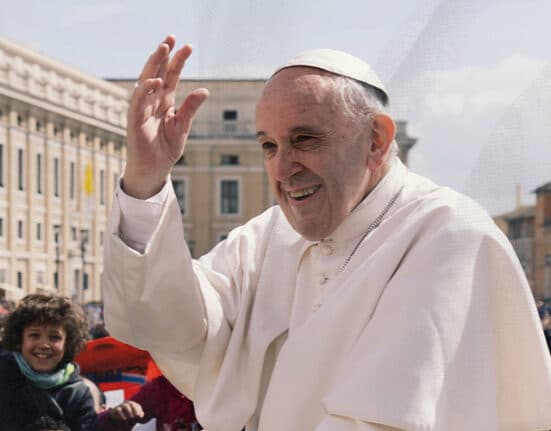FOR many years, Jorge Mario Bergoglio; famously known as Pope Francis had served as the supreme of those who follow Roman Catholic beliefs after the reign of Pope Benedict XVI.
Pope Francis—a well-beloved Pontiff to many, uses his influences to strongly advocate for social justice and give his great love and care for those who are poor.
As we bid our final adieu to the pope that served us for more than a decade, let us look at the life and works of Pope Francis.
Early life
Born on December 17, 1936, at Flores, Buenos Aires, Argentina; Jorge Mario Bergoglio was the eldest of the five children of Mario José Bergoglio and Regina María Sívori. In his early life, he then attended secondary school in Escuela Técnica Industrial and graduated with a chemical technician’s degree.
For several years, Bergoglio spent several years working as a chemical technologist and a bouncer in Bueno Aires, Argentina.
At the age of 21, he found himself infected with a severe respiratory infection in his native Argentina. Because of this severe infection, he then underwent surgery that removed part of his lungs.
September 21st marks a special day for young Bergoglio as on his way to a party, he first confesses at a church, and from there, he has an experience of mercy that lead him to his path as a priest.
He later became a novitiate of the Society of Jesus on March 11, 1958, and after completing his humanities coursework in Chile, he then returned to Argentina in 1963 to earn his philosophy degree from Colegio de San José in San Miguel, Buenos Aires, Argentina.
On December 13, 1969, just a few days before his 33rd birthday, Bergoglio was ordinated into the priesthood.
At Immaculate Conception College in Santa Fé, he became an educator of psychology and literature from the years of 1964 to 1965. In 1966, he taught the same subjects at Colegio de Salvatore, Buenos Aires.
Bergoglio then obtained his Theology from Colegio of San José in 1970.
A journey to priesthood
On his journey to priesthood, he continued his training between 1970 and 1971 at the University of Alcalá de Henares, Spain. On April 22, 1973, he made his final profession with the Jesuits.
During his return to Argentina, he was a novice master at Villa Barilari, San Miguel. He also expanded his profession as a consultor to the Province of the Society of Jesus, a Rector of the Colegio Máximo of the Faculty of Philosophy and Theology, and a professor at the Faculty of Theology of San Miguel.
Bergoglio was appointed as the “Provincial of the Jesuits in Argentina,” on July 31, 1973–an office that he served for in the capacity of six years. After that he went back to work in the university sector–serving as a Rector of the Colegio de San José and a parish priest from 1980 to 1986.
After completing his doctoral thesis in Germany in March 1986, his superiors sent him to serve as a confessor and spiritual director at the Colegio del Salvador in Buenos Aires and next to the Jesuit Church in Córdoba.
The Archbishop of Buenos Aires, Cardinal Antonio Quarracino, wanted him to collaborate closely with him. He was therefore named Auxiliary of Buenos Aires and titular Bishop of Auca by Pope John Paul II on May 20, 1992.
On May 27, Bergoglio received episcopal ordination from the Cardinal in the cathedral. He was later chosen as his episcopal motto, miserando atque eligendo, and on his coat of arms inserted the ihs, the symbol of the Society of Jesus.
His first interview as a bishop was published in the parish newsletter, Estrellita de Belén. On December 21, 1993, he was immediately given the position of Vicar General of the Archdiocese after being designated Episcopal Vicar of the Flores district.
He was later raised to the dignity of Coadjutor Archbishop of Buenos Aires on June 3, 1997, and not even nine months had passed; upon the death of Cardinal Quarracino, he succeeded him as Archbishop, Primate of Argentina and Ordinary for Eastern-rite faithful on February 28, 1998.
On February 21, 2001; John Paul II created him Cardinal at the Consistory where he was assigned to the title of San Roberto Bellarmino. Bergoglio then ask John Paull II not to come to Rome to celebrate him being the Cardinal but rather have him donate the money to the poor.
Following his journey as the Grand Chancellor of the Catholic University of Argentina, he then author the books: Meditaciones para religiosos (1982), Reflexiones sobre la vida apostólica (1992) and Reflexiones de esperanza (1992).
On October, on the 10th Ordinary General Assembly of the Synod of Bishops on the Episcopal Ministry, he was appointed General Relator.
He was given this responsibility at the last minute to succeed Cardinal Edward Michael Egan, the Archbishop of New York, who was forced to remain in his country due to the 9/11 terrorist attacks.
Bergoglio gave special attention to “the prophetic mission of the bishop,” his role as a “prophet of justice,” his obligation to “preach ceaselessly” the Church’s social doctrine, and his ability “to express an authentic judgment in matters of faith and morals” throughout the Synod.
In the Latin America, the popularity of Cardinal Bergoglio grew and despite the growing attention on him, he never relaxed his sober approach or his strict lifestyle.
He declined to be appointed at the president of the Argentine Bishops’ Conference in 2002 but was then elected three years later. In April 2005, the took part in the Conclave in which Pope Benedict XVI was elected.
He developed a missionary endeavor centered on evangelization and communion while serving as Archbishop of Buenos Aires, a diocese with a population of over three million. Open and fraternal communities, an informed laity taking the lead, evangelizing activities directed at all city dwellers, and aid for the ill and impoverished were his four key objectives.
Becoming Pope Francis
On March 13, 2013, Jorge Mario Bergoglio was elected Supreme Pontiff at the age of 76. He succeeded after Pope Benedict XVI who resigned due to declining health caused by old age and took the name Francis in his pontificate.
He chose to take the name “Francis” in honor of St. Francis of Assisi because he was the lover of the poor.
During his time as the Pope, Pope Francis took actions that reflected his vision of a more compassionate, more inclusive, and reform-minded Catholic church. He took commitment to making the chruch more relevant in modern times–leaning his progressive stance on social issues.
This vision of him later brought both praise and criticism in his papacy.
In 2015, one of his most notable contributions in his encyclical Laudato Si’ addresses the environmental crisis, and the call for action was well popularized with the pope linking environmental degradation to social inequality. Through this, he urges the faithful and the global community to take responsibility for the environment.
The pope had also reformed the Vatican through their financial operations and had the world to address corruption and mismanagement. Through this, he initiated the Vatileaks investigation into leaking sensitive documents.
Aside from addressing the financial mismanagement, he took a step on improving the transparency of the Chruch finances including the introduction of accountability upon its operations.
Pope Francis has also made efforts to confront the issue of sexual abuse that is occurring within the church, enacting stricter policies when it comes to handling cases of abuse.
The faithful had also included his compassion when it come to Family and Gender issue, leading the Synod on the Family in 2014 and 2015 which addressed the issues on LGBT rights, divorces, and remarriage.
While maintaining the doctrine, he called for a more compassionate and pastoral approach to those who are facing these challenges.
How useful was this post?
Click on a star to rate it!
Average rating 5 / 5. Vote count: 1
No votes so far! Be the first to rate this post.
We are sorry that this post was not useful for you!
Let us improve this post!
Tell us how we can improve this post?







